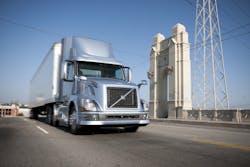WASHINGTON, D.C. Following 2015’s robust sales of 300,000 Class 8 trucks in North America, this year’s forecast of 260,000 units represents “the new normal,” according to Goran Nyberg, president of Volvo Trucks North America.
“Coming from 300,000 down to 260,000 can be concerning, but we’re coming off a peak year,” he said at a press briefing. “We have to adjust to this new normal and realize we are still having a very good year.”
With inventories currently high, dealers are now working through that backlog, and sales will remain relatively low in the first and second quarter, Nyberg said. However the company is looking forward to a strong second half pushing heavy-truck sales to that 260,000 level, he said.
As a brand, Volvo hit a record U.S. market share in 2015, according to Magnus Koeck, VP marketing and branding. The company’s integrated powertrain strategy in particular gained traction, with 93% of Volvo trucks sold fitted the company’s proprietary diesel engines and 83% with its IShift automated mechanical transmission. Volvo’s XC downspeeding powertrain package also achieved significant penetration at 27% of sales, Koeck said.
Turning to the recently announced reorganization of the global Volvo Trucks group, Nyberg said each of the company’s five truck brands – Volvo Trucks, Mack Trucks, UD Trucks and Renault Trucks – would operate as separate organizations around the world. While previously Volvo and Mack Trucks had operated together in this country under the Volvo Trucks umbrella, now as president of Volvo Trucks North America, Nyberg reports directly to Volvo Trucks global president Claes Nilsson. Mack will be headed globally by Denny Slagle, who now reports to Volvo Group CEO Martin Lundstedt.
“Customers are buying from brands,” Nyberg said, explaining that both Volvo and Mack brands will have separate organizations here in North America, but will continue sharing services that support both brands. With the Volvo brand well established in regional and long haul sleeper segments of the N.A. Class 8 market, it will now look at growing penetration in industrial segments like petrochemical, intermodal and regional distribution applications, he said. “With our powertrains, we feel we can be extremely competitive in any weight sensitive applications, including day cab ones,” Nyberg said.
Truck connectivity and its potential to bring major gains in truck uptime will also continue to be a major focus for the Volvo brand, according to the executives. “The more vehicles we can connect, the more data we have and the more predictive our support can be,” Nyberg said. The company’s remote diagnostics and connectivity uptime service, which is now standard on every new truck, has already cut unplanned downtime per truck by one or two days on average, he said.
As that remotely collected database increases, “we could see a real game changer for the industry with proactive replacement of parts and components in a planned way based on data projections,” Nyberg said. He added that this year Volvo would bring over 100 dealers into its Certified Uptime Center network, guaranteeing rapid triage and repair times with dedicated facilities.
Turning to another aspect of truck connectivity, Koeck mentioned that Volvo would provide three tractors to the California’s Berkley University for a truck platooning research project later this year.
Volvo is convinced that truck platooning and other aspects of autonomous truck operations will arrive in the near future. Demand will come faster than we think, but it will be step by step, not in a big bang,” said Nyberg. “It will be driven by product features that help trucks be safer and more efficient.”
About the Author
Jim Mele
Jim Mele is a former longtime editor-in-chief of FleetOwner. He joined the magazine in 1986 and served as chief editor from 1999 to 2017.
